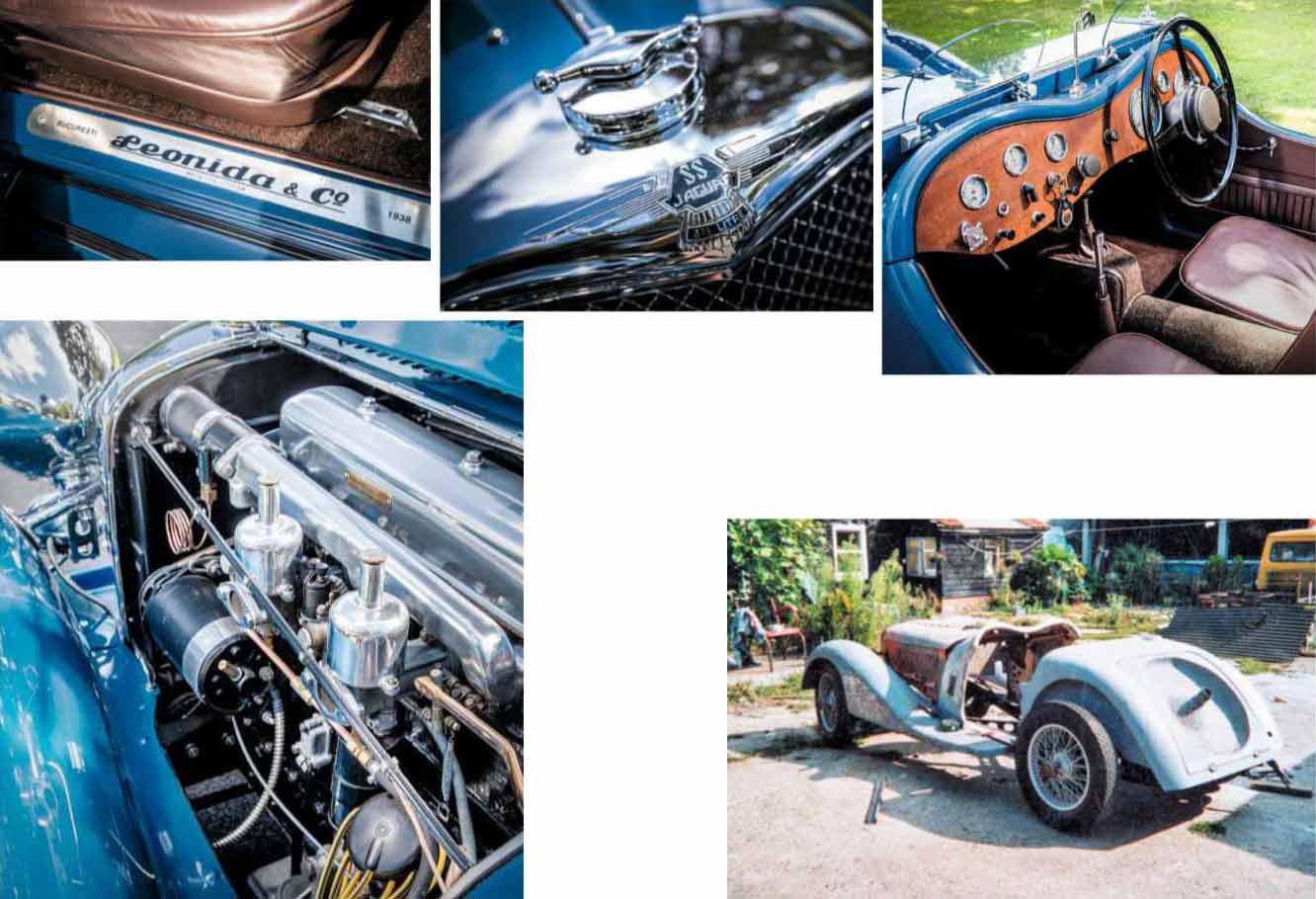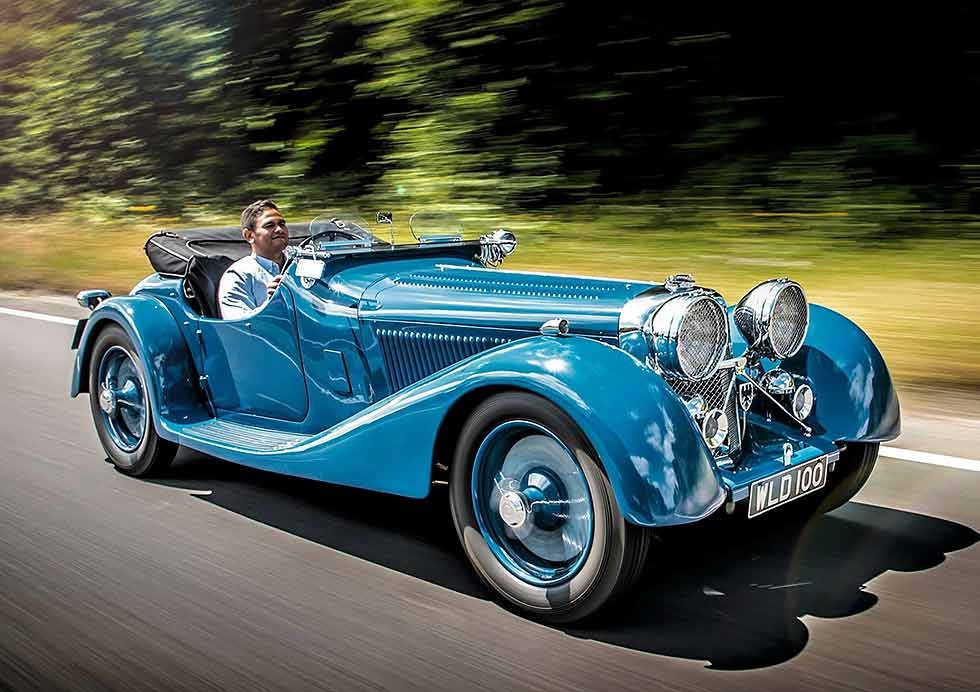
Unique Leonida Jaguar driven. We took this Leonida-bodied Jaguar for a drive, and unfolded its story… Royal Blue… We drive the only Leonida-bodied Jaguar SS100 and explore its amazing past involving Romanian royalty and more. This unique SS Jaguar 100 hides a tale of mystery, Royalty and turbulent 20th Century politics within its art-deco lines. We drive it, the only Jaguar to be bodied in Romania. Words Sam Dawson. Photography Charlie Magee.
For the best part of half a century, the car you’re looking at here enjoyed almost mythical status. Like the feet of the Colossus of Rhodes or the grainy Thirties film clip of the last surviving thylacine, the existence of the ‘Romanian Jaguar’ was confirmed only by documentation: a double-order in the books of SS Cars for a pair of Jaguar 100s; chassis 39001 – the very first 3.5-litre roadster – and this one, 39070, specified as a bare chassis to be delivered to the coachbuilder Leonida & Co of Bucharest and built as an Open Two-Seater. It went unseen by British eyes until it finally emerged in a rusty, dismantled state at a Coys auction in 2000. Now it’s fully restored and sitting in the grounds of Orsett Hall, ready for me to drive.
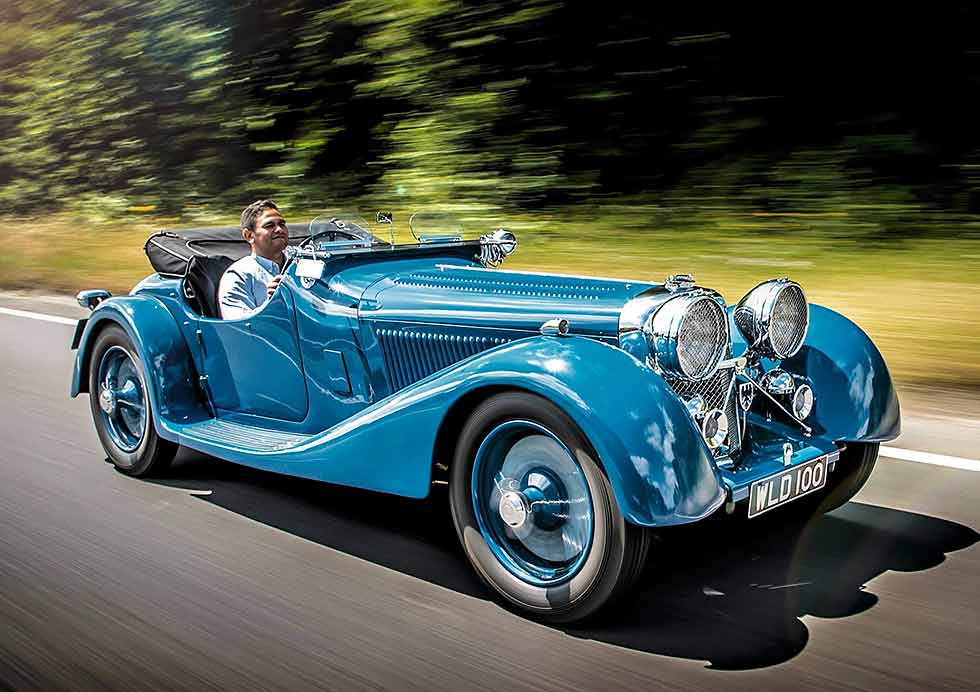
That double-order was placed in 1937 via Bucharest dealer Anglo Cars by Queen Marie of Romania. The complete 39001 roadster with its standard SS coachwork was presented to her grandson Michael, then Crown Prince of Romania, upon his 17th birthday in 1938 as part of a coming-of-age ceremony in which he was also put in ceremonial charge of the Romanian Air Force. But the story of 39070 is much less clear-cut, yet all the more tantalising for it. All because of the turbulent events occurring in the country between the late Thirties and the late Seventies, and the presence in the tale of a flamboyant engineer and occasional racing driver by the name of Jean Calcianu.
In 1937, the much-loved Queen Marie was suffering from terminal pancreatic cancer, and was confined to a sanitorium in Italy. Her son, King Carol II, who had returned from exile following his affair with socialite Magda Lupescu and ensuing divorce, deposed the Regency of the teenage King Michael, demoted him and established a dictatorship.
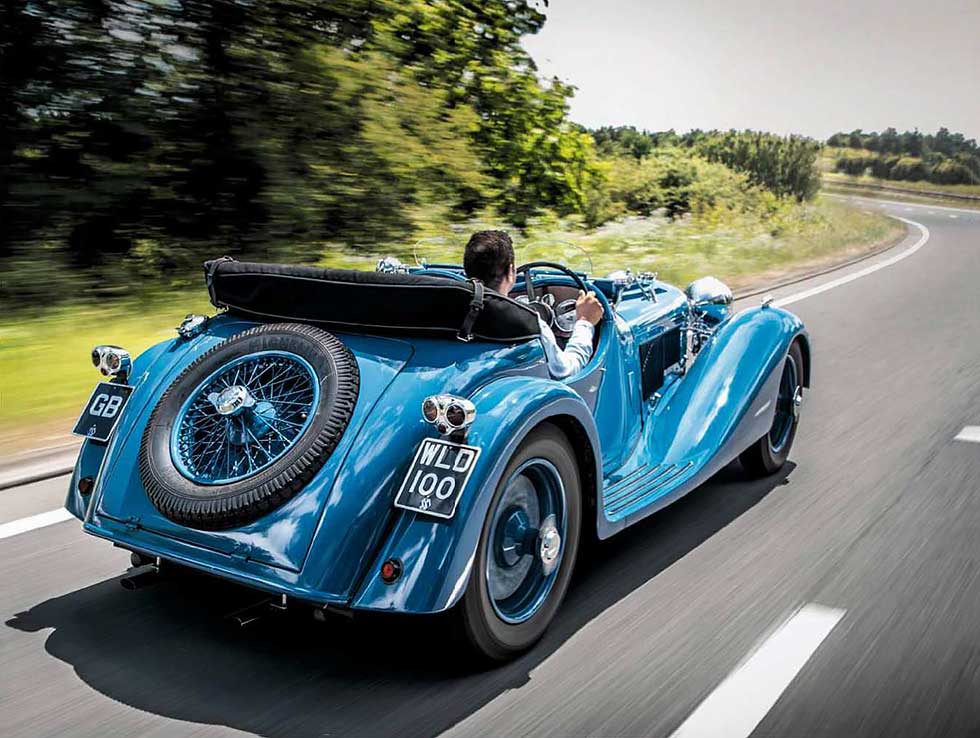
But during her time in Italy, the Queen also received a visitor in the form of her ‘favourite son’ Nicholas, formerly the Prince Regent, exiled to Spain by Carol II in a power play that used his marriage to divorcee Ioana Dumitrescu-Doletti as justification. The dashing aviator Time magazine dubbed ‘speed-fiend Nicholas’ also contested the 1933 and 1935 Le Mans 24 Hours behind the wheel of a Duesenberg SJ special.
At Leonida, a coachbuilder founded by the Romanian engineer Dimitrie, a streamlined shape took the place of the SS100’s usual stark sports-car bodywork. The distinctive radiator grille with its wishbone-shaped headlamp supports makes it seem more familiar at first glance. But then you see the helmet-like wings enclosing the front wheels, the higher scuttle with its low, speedster-style windscreen, and the sloping tail which elegantly semi-encloses a spare wheel. View it from the side or rear three-quarter and there’s something distinctly French about it, and it’s not just the blue paint. There’s a good reason for that.
The man who devised this car was Jean Calcianu, a polymathic engineer who left Bucharest for Paris in 1914 to work for Renault, helping to invent the tank during the First World War before moving to Grenoble to work for Corniot and look after André Dubonnet’s fleet of racing Bugattis. Dubonnet indulged Calcianu with an old Type 37, which he modified aerodynamically, achieving 173.6km/h (108mph). Calcianu’s attention to detail – in particular, the countersinking of screws into the bodywork and the subtle smoothing of square edges – impressed Ettore Bugatti, who hired him to work as a test driver.
Calcianu held the position at Molsheim for six years before returning to his native Romania to set up a Bugatti dealership in Bucharest, lodging a FF5000 deposit guarantee with Ettore. But the arrangement didn’t last. Calcianu’s ailiations switched to Duesenberg, and a customer who’d become a close friend – Prince Nicholas. His Le Mans Duesenberg was an early Calcianu-Leonida collaboration, so it’s not hard to work out who the ultimate owner of this expensively-created, Royal-ordered Jaguar was intended to be. But events would ultimately turn against it.
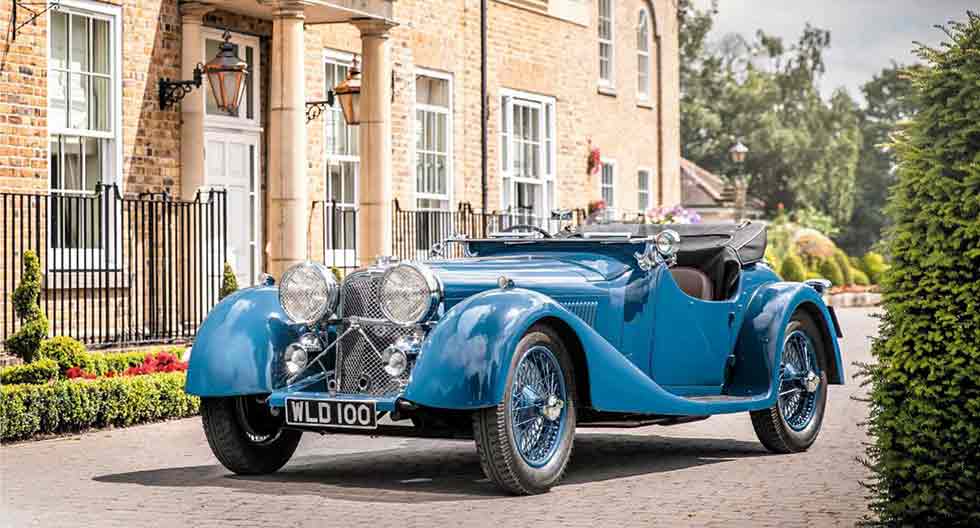
I don’t know how tall Prince Nicholas was, but he wouldn’t have had much room inside this Jaguar. Getting in is an ordeal unless you’re markedly shorter-legged than average. I have to crank my left knee over at an angle known only to yoga instructors to clear the vast steering wheel, before sliding into the seat, opening the rear-hinged door wider, and dragging my right leg in at a similar angle. Space is at such a premium that my lower legs are completely folded round, and I have to operate the pedals with the outside edges of my feet. Amazingly, the higher scuttle of Calcianu’s design was supposed to give the Leonida Jaguar more legroom than the standard SS100.
Press the starter button, tap the throttle, and the 3485cc straight-six bursts into life with a deep, percussive baritone. It would have been even louder when it was new – Calcianu intended it to be a racer, possibly to succeed Prince Nicholas’ Duesenberg, and it sported four deafening open exhaust pipes. The adjustable friction-disc dampers remain, as does the larger, lower-profile endurance-specification coolant tank. The early double-helical-cut racing version of the Moss gearbox is sadly long gone – it was a short-lived experiment adapted from heavy-duty marine practice, also investigated and abandoned by Citroën and MG in the Thirties after it proved prone to stripping teeth.
The conventionally-cut Forties-spec Moss gearbox installed today engages slickly and cleanly. I twist my right foot painfully and acceleration is instant and vigorous. It’s a product of the car’s lightness – Leonida used aluminium rather than SS’s standard pressed steel, so even given the more extensive metalwork of Calcianu’s design, it’s a fair bet it weighs a lot less than the normal 100 3.5-litre’s surprisingly hefty 1181kg.
It’s even more impressive in corners. I aim it at a very tight left-hand of-camber bend running into a narrow avenue of trees, and although the wheel demands a lot of shoulder power to muscle it through, the low-slung chassis is unfazed by the sudden change of direction, the car remaining impressively neutral. I change up through the gears, still impressed with the ’box – the Moss never felt this precise and positive in an early E-type, let alone an XK. If your shift timing is slightly out you’ll feel a jarring crunch jumping through the palm of your hand like a mild electric shock, but this merely forces you to think more carefully about changing gear. Accelerating harder, the thudding engine note is replaced with a high-pitched, almost supercharger-like whine from the gearbox. It’s the sophisticated note of a neatly-balanced instrument machined to fine tolerances and running at high speeds.
Although it’s a very hot day with correspondingly still, muggy air, as I pick up speed I can feel Calcianu’s aerodynamics working. My face is exposed behind this low-set windscreen but I’m not being blasted by the wind – it’s rushing neatly of the scuttle and over my head. I’ve no doubt a similar low-smoothing function is being performed by those low-plunging front wings too. Tellingly, Calcianu worked for Romanian aircraft manufacturer IAR following the termination of his Bugatti deal, so unlike some of the French carrossiers of the Thirties, there was genuine aerodynamic theory behind his designs, rather than extravant guesswork.
The brakes, sadly, are one major reminder that I’m in a machine of the Thirties; they fade alarmingly quickly no matter how progressive you’re being. Unfortunately the bodywork probably doesn’t help – these lowing teardrops will trap heat like an oven. We don’t know whether it was these brakes, the ultimate limits of its roadholding or Calcianu’s own shortcomings that made for the first incident in this car’s long fall from grace. Shortly after building it, he drove it in a street race at Câmpina and crashed, damaging the body and repairing it himself at IAR. It’s unlikely, given his exile in Spain as of 1937, that Nicholas ever got the chance to drive the car created for him, because ten years later it was still in Romania. According to correspondence current owner Nick Williams had with King Michael I during his restoration of the Jaguar, Nicholas’ cars were never kept in the Royal garages, so it’s likely Calcianu stored it alongside the Duesenberg.
The car was lucky to survive World War Two. In 1940, following the threat of Soviet invasion, Carol II ceded power to Ion Antonescu, a Fascist who aligned Romania with Nazi Germany and perpetuated the Holocaust on domestic soil. Michael led a successful coup in 1944 and realigned the nation with the Allied powers. However, the Soviet troops who had aided Michael’s victory then refused to leave. A rigged election followed resulting in the installation of a Soviet puppet regime. Michael’s triumph had lasted just three years before he too was exiled by Stalin. This sudden rise of anti-Monarchist Communism meant Nicholas knew he still couldn’t return to Romania. In 1947 he signed the decade-old car over to his lying instructor, Captain Cula of the Romanian Royal Air Force, but Cula was killed in an aeroplane crash not long afterwards. The car passed to Cula’s wife, whose solicitor took it in lieu of payment for a debt.
The late Forties were a tough time to be a car enthusiast in Romania. In 1948 Englishman Ernest Dawyl, owner of SS Jaguar’s Bucharest importer Anglo Cars, was arrested on suspicion of espionage. Meanwhile, the contents of the Royal garage were quickly sold to trusted enthusiasts without obvious connections to the family – the new owner of Michael’s SS100 had it rebodied in Calcianu’s style by Leonida, albeit without the revised scuttle. All the while the Communist secret police, the Securitat, monitored sales of cars, ready to requisition any former Royal property.
Amid this climate of fear, Mrs Cula contacted Nicholas Mazilu, a trusted car enthusiast who she igured would make a better owner for the Jaguar than her solicitor, and whose purchase of it would clear her debts. To make sure of the sale, Mazilu bribed a Securitat officer to accompany him to the solicitor’s house. It worked, but ironically Mazilu was stopped by another Securitat officer on his way home in the car for making too much noise – it still wore its quad open exhausts. Mazilu was lucky to escape with a stamp in his licence. Just three stamps would have seen the car confiscated.
Mazilu’s ownership lasted until January 1955 – his wife reputedly said it was attracting too much attention. Mazilu sold the car to Dr Viorel Pop, an unsavoury character who made a fortune performing illegal backstreet abortions. He crashed the car and had it repaired in secret at Calcianu’s old workshop in the Brasov IAR factory. After this the trail goes cold until a room of dismantled, rusty but complete parts was uncovered in neighbouring Hungary in 2000. However, what happened to another of Calcianu’s cars gives us a fairly clear picture of what fate might have befallen chassis 39070.
For all his prowess as an engineer and his signiicance in motor sport – in 1934 he organised the first Romanian closed-road race, in Brasov – Calcianu was never the driver he wished he was. He was accomplished as a national-level sports car road-racer in France and Romania, with wins on the Lafrey Coast and at Miramas in a Talbot. However, amid the fog of war and later as the Iron Curtain descended, Calcianu had a tendency to embellish his own past.
He’d claim it was his prowess on the track, not as a designer, that led Bugatti to hire him. His biggest fib involved him winning the 1939 Belgrade Grand Prix when Tazio Nuvolari was unable to get from Italy to Serbia due to a travel ban imposed upon Mussolini’s citizens. In reality, Nuvolari’s passage to Belgrade was secured by a column of Wehrmacht tanks, and the race was a victory for his Auto Union. Not that anyone noticed – Hitler invaded Poland on the same day. As the Cold War began, Soviet authorities had any trace of this Axis propaganda victory on Balkan soil airbrushed from history, so Calcianu could say what he liked about it.
Unsurprisingly, it wasn’t long before Calcianu attracted the Securitat’s attention. In the same year the Leonida Jaguar’s history comes to a halt, officers paid a visit to his workshop and found the ex-Nicholas Duesenberg under a tarpaulin. It was requisitioned and taken to the Club Sportiv Steagu Rosu (Red Flag Sports Club), a collection of racing cars deemed to belong to the nation. A car like the Leonida Jaguar would have had to be taken of the road and hidden to avoid this fate. The ex-Michael I SS100 was smuggled into Greece and restored.
Two decades later, things were even more desperate. Under the totalitarian dictatorship of Nicolae Ceausescu, with the country plunged into poverty, the Communist government started to liquidate national assets. Calcianu’s Le Mans Duesenberg was identified as an ideal candidate, but in response someone from the Dimitrie Leonida Technical Museum dismantled it, removing several vital engine components to ensure it couldn’t be sold as a working car. It remains in the Museum to this day, a monument to Romanian craftsmanship rather than political wrangling.
It’s not hard to see, against this desperate backdrop, how the Leonida Jaguar ended up disappearing for 45 years only to be found in bits in a Hungarian garage. However, there’s a bizarre footnote to its story. In his 1984 book Jaguar SS90 & SS100 Super Profile, the late Jaguar authority Andrew Whyte, having unearthed a picture of Michael I, Ernest Dawyl and the first 3.5-litre SS100, noted that the Royal family ‘imported this car, plus a chassis (39070) subsequently reported in the USA with a MkV engine.’
When the car’s remains were discovered, the chassis plate was missing. It was identified by its unique body, and the engine number M774E. Could it be that a Ceausescu apparatchik managed to rake in some American cash by selling of a genuine SS Jaguar 100 chassis plate, allowing a backyard restorer to authenticate a bitsa? As with so many aspects of this car, it’s a tantalizing mystery.
Tech and photos
TECHNICAL DATA FILE SPECIFICATIONS 1938 SS Jaguar 100 by Leonida
Engine 3485cc in-line six-cylinder, ohv, two SU H4 carburettors
Max Power 125bhp @ 4250rpm / DIN nett
Max Torque 187lb ft at 2300rpm / DIN nett
Transmission Four-speed manual, rear-wheel drive
Steering Worm and nut
Suspension Front: beam axle, Luvax hydraulic and Hartford adjustable friction dampers, semi-elliptic leaf springs. Rear: live axle, Luvax hydraulic and Hartford adjustable friction dampers, semi-elliptic leaf springs
Brakes Rod-operated drums front and rear
Weight n/a, lighter than standard 1181kg because of aluminium bodywork
Performance Top Speed: 100mph+ (est); 0-60mph: 10.5sec (est)
Fuel consumption 21mpg
Value now £700,000
‘As I pick up speed I can feel Calcianu’s aerodynamics working’
Political turmoil in Romania and a subsequent half-century in hiding had taken its toll on the unique SS100. With lighter-than-usual coachwork, Prince Nicholas’ car would have had no trouble reaching the SS100’s namesake top speed. Beneath the long bonnet sits the standard SS100’s 3.5-litre straight-six.
